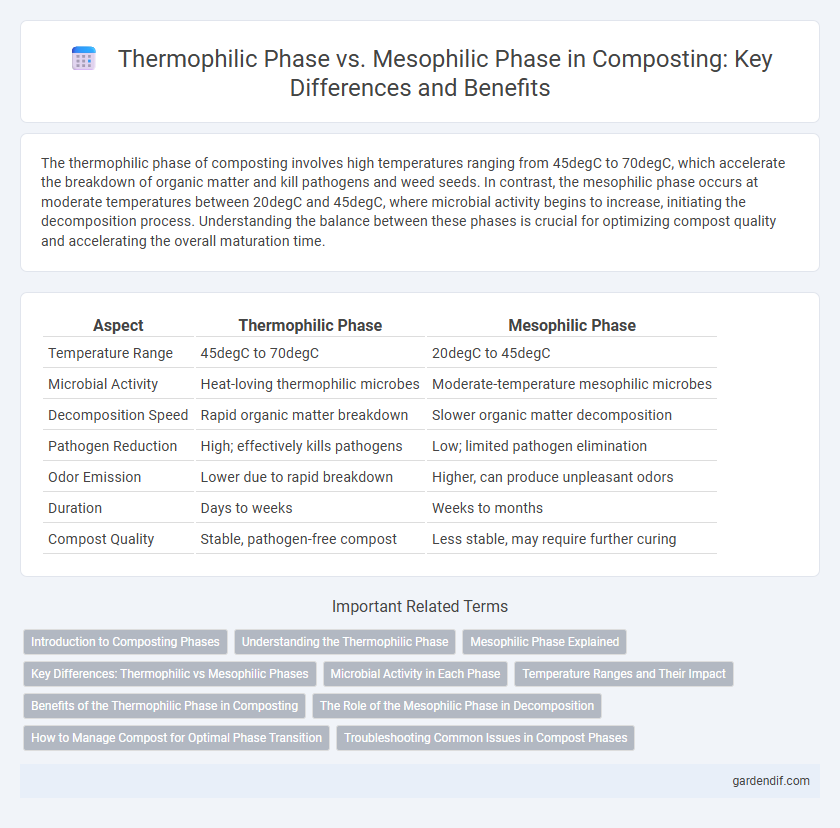
Thermophilic Phase vs Mesophilic Phase Illustration
The thermophilic phase of composting involves high temperatures ranging from 45degC to 70degC, which accelerate the breakdown of organic matter and kill pathogens and weed seeds. In contrast, the mesophilic phase occurs at moderate temperatures between 20degC and 45degC, where microbial activity begins to increase, initiating the decomposition process. Understanding the balance between these phases is crucial for optimizing compost quality and accelerating the overall maturation time.
Table of Comparison
| Aspect | Thermophilic Phase | Mesophilic Phase |
|---|---|---|
| Temperature Range | 45degC to 70degC | 20degC to 45degC |
| Microbial Activity | Heat-loving thermophilic microbes | Moderate-temperature mesophilic microbes |
| Decomposition Speed | Rapid organic matter breakdown | Slower organic matter decomposition |
| Pathogen Reduction | High; effectively kills pathogens | Low; limited pathogen elimination |
| Odor Emission | Lower due to rapid breakdown | Higher, can produce unpleasant odors |
| Duration | Days to weeks | Weeks to months |
| Compost Quality | Stable, pathogen-free compost | Less stable, may require further curing |
Introduction to Composting Phases
The thermophilic phase of composting is characterized by high temperatures ranging from 45degC to 70degC, where heat-loving microorganisms actively break down organic matter, accelerating decomposition and pathogen destruction. In contrast, the mesophilic phase occurs at moderate temperatures between 20degC and 45degC, involving mesophilic microbes that initiate the breakdown of simpler organic compounds. Understanding these composting phases is essential for optimizing microbial activity, nutrient cycling, and the production of high-quality compost.
Understanding the Thermophilic Phase
The thermophilic phase in composting occurs at temperatures between 45degC and 70degC, where thermophilic microorganisms actively break down organic matter, accelerating decomposition and pathogen destruction. This phase enhances nutrient availability and stabilizes the compost by reducing phytotoxic compounds found in immature compost. Understanding the thermophilic phase is crucial for optimizing compost quality and ensuring effective microbial activity during the composting process.
Mesophilic Phase Explained
The mesophilic phase of composting occurs at moderate temperatures ranging from 20degC to 45degC, where mesophilic microorganisms actively break down organic matter into simpler compounds. This phase is crucial for initiating decomposition and preparing the substrate for the subsequent thermophilic phase by producing heat and organic acids. Efficient mesophilic activity enhances nutrient availability and microbial diversity, setting the foundation for successful compost maturation.
Key Differences: Thermophilic vs Mesophilic Phases
The thermophilic phase of composting operates at temperatures between 45degC and 70degC, accelerating organic matter breakdown through heat-loving microbes, while the mesophilic phase occurs at cooler temperatures of 20degC to 45degC, involving slower decomposition by moderate-temperature microorganisms. Thermophilic microbes rapidly reduce pathogens and weed seeds due to the elevated heat, whereas mesophilic microbes initiate the composting process, breaking down soluble compounds and allowing thermophilic organisms to thrive. The shift from mesophilic to thermophilic phases marks a critical transition in compost maturation, with temperature and microbial activity serving as key distinguishing factors.
Microbial Activity in Each Phase
Thermophilic phase of composting features temperatures between 45degC and 70degC, during which thermophilic microbes such as Bacillus and Actinobacteria dominate, accelerating organic matter breakdown through intense enzymatic activity. The mesophilic phase operates at lower temperatures (20degC to 45degC) and supports mesophilic microbes like Lactobacillus and Pseudomonas, which initiate decomposition by breaking down simple sugars and proteins. Microbial diversity shifts significantly from mesophilic to thermophilic phases, optimizing the composting process through sequential microbial succession and enhanced biodegradation efficiency.
Temperature Ranges and Their Impact
Thermophilic phase in composting occurs at temperatures between 45degC and 70degC, accelerating the breakdown of organic matter and killing pathogens, while the mesophilic phase operates between 20degC and 45degC, supporting microbial diversity and initial decomposition. Higher temperatures in the thermophilic phase enhance enzymatic activity and pathogen reduction but may inhibit certain beneficial microbes active during the mesophilic phase. Managing temperature ranges optimizes compost quality by balancing rapid decomposition with microbial community dynamics essential for nutrient cycling.
Benefits of the Thermophilic Phase in Composting
The thermophilic phase in composting, characterized by temperatures between 45degC and 70degC, accelerates the breakdown of organic materials and eliminates harmful pathogens and weed seeds, ensuring a safer and more stable compost. High microbial activity during this phase enhances nutrient mineralization, resulting in nutrient-rich end products that improve soil fertility. This phase also reduces composting time compared to the mesophilic phase, increasing overall efficiency in waste management and organic recycling.
The Role of the Mesophilic Phase in Decomposition
The mesophilic phase plays a crucial role in the early stages of compost decomposition by breaking down readily degradable organic matter at moderate temperatures between 20degC to 45degC. Mesophilic microorganisms, including bacteria and fungi, initiate the decomposition process by metabolizing sugars, proteins, and simple carbohydrates, creating conditions that support the subsequent thermophilic phase. This phase ensures the rapid reduction of organic waste volume and prepares the substrate for enhanced pathogen destruction and nutrient mineralization during the thermophilic phase.
How to Manage Compost for Optimal Phase Transition
Managing compost for optimal phase transition requires maintaining temperatures between 40-70degC to support the thermophilic phase, which accelerates organic matter breakdown and pathogen destruction. Ensuring adequate aeration by frequent turning promotes oxygen flow, preventing anaerobic conditions and facilitating the shift from the mesophilic (20-40degC) to thermophilic phase. Moisture content should be kept around 50-60% to optimize microbial activity during both phases, enabling efficient decomposition and minimizing odor emissions.
Troubleshooting Common Issues in Compost Phases
Thermophilic phase issues in compost often involve overheating, which can kill beneficial microbes and slow decomposition, while mesophilic phase problems typically include slow microbial activity due to insufficient moisture or aeration. Monitoring temperature between 45degC to 70degC during the thermophilic phase ensures pathogen destruction and rapid breakdown, whereas maintaining 20degC to 45degC in the mesophilic phase supports microbial diversity and stabilization of organic matter. Effective troubleshooting requires balancing moisture content around 50-60%, ensuring proper aeration, and adjusting feedstock composition to optimize microbial activity across both composting phases.
Thermophilic Phase vs Mesophilic Phase Infographic

 gardendif.com
gardendif.com